Thick, dark clouds have started to form ahead and it’s beginning to look like a decent sprinkling of rain is not far away. What a perfectly good opportunity to give your house plants a good drink with some “al naturale” rainwater, right?
Not so fast.
Some indoor plants quite enjoy rainwater and outdoor conditions (as long as they aren’t too extreme). But there are some less adventurous house plants that definitely do not consider exposure to outdoor conditions such a great idea.
So when can I put my houseplants outside in the rain?
Well, that’s exactly the question we are going to go over here.
In this post, I’ll break down which plants love the rain and which ones don’t, as well as give some tips and tricks on how you can keep your plants safe while they explore the great outdoors.
Rules of thumb for putting your indoor plants outside
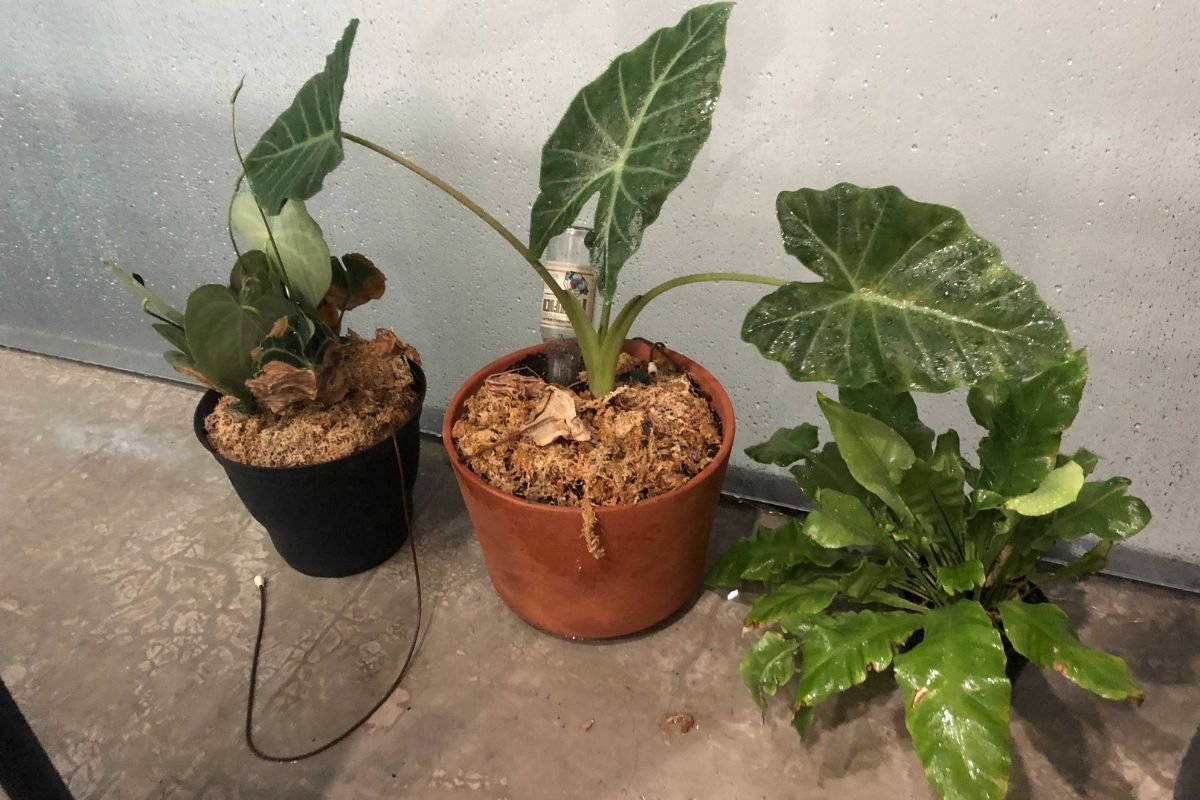
Indoor plants have adapted to indoor conditions, consequently, a sudden change in their environment can be a huge stress on them. And, in some instances, if conditions are too drastically different they can become damaged or at worse even die.
To help you avoid this type of devastation, here are a few rules of thumb you should apply when putting your house plants outdoors.
Be vigilant of excessive sun exposure
It’s super important to note, even if your houseplant is usually positioned in a place where it receives a lot of direct sunlight, that doesn’t necessarily mean it will enjoy the sunlight it is likely to encounter outdoors. Even the sunniest spot in your house will not compare to the intensity of the outdoor sunlight.
To avoid any catastrophes, be sure to place your indoor plant somewhere where there is ample shade, even if the clouds are thick and it’s raining heavily. It only takes a few clouds to clear, you to be busy, and your plant baby will soon be getting a suntan it’d rather not receive.
Bearing that in mind, placing an indoor plant beneath a tree or nestled safely under some hanging shade cloth will work best. And, as an added bonus, the extra cover will limit the amount of water a plant is receiving, making completely soaking its growing medium less likely.
I will add, If the rain is light or only sprinkling, of course, it’s okay to place your houseplant in the open. If you do this, though, be sure to set yourself a reminder notification on your phone or be close by just in case the weather conditions suddenly change.

Don’t overwater
One of the number one ways to make any indoor plant unhappy is by overwatering it. I cannot even tell you how many times I’ve had trouble with root rot, drainage issues, plant malnutrition, molds, mildews, and the like, simply by overwatering a plant. So when you think about it, placing your house plant in conditions that exceed its normal water allocation can cause a whole plethora of issues.
To avoid this, it’s best to limit how much rain a plant receives when placed outside. As I only just mentioned above, placing your house plant under a tree or beneath some shade cloth works well. Another great strategy I’ve found that works well is to place your plant at the edge of a house balcony, verandah, or porch. Close enough to the perimeter of the roof overhang but not completely open to the rain. A place that I call the “splash zone”. A position that receives splashes of water that bounce off concrete, cement, paving, or hard ground but is not completely exposed to the open sky.
That way, if it starts to rain particularly heavily, your plant is protected from overwatering and the many issues that come with it.
Ensure the plant has adequate drainage
For some incomprehensible reason, not all planters or pots are designed with drainage holes (you can make your own planters with drainage, though!). For this reason, it’s very important to avoid putting indoor plants out in the rain that either isn’t grown in a pot with drainage holes or that aren’t in a medium that promotes adequate drainage.
Without good drainage, potting soil can become a soupy, soggy, waterlogged mess. Conditions that just about every house plant will certainly prefer not to be subjected to.
Prevent exposure to heavy rain

Aside from overwatering, super heavy rain has the potential to shred leaves, break limbs, or even bruise soft plant tissue, particularly if that rain is coupled with hail. To back up my splash zone technique, this is why a spot where changing weather conditions can easily be navigated is most desirable. The best spots consist of a place where indoor plants are receiving the right amount of moisture, are not subjecting them to harsh weather extremes, and will protect them from damaging heavy rain if the weather is to change unexpectedly.
After all, it’s best to be overly cautious than to throw caution to the wind and end up with a very unhappy house plant that you have to nurse back to good health.
Consider strong winds and gusts
With tumultuous weather patterns, events that generally bring plenty of rain, often come strong winds and gusty conditions. And this is something you’ll definitely want to keep in mind when choosing the best spot to place indoor plants in while they are venturing outside. A sudden and unexpected gust of wind can knock a plant over, spill its soil, and even crack or break terracotta or other fragile pots.
For this reason, if you can find a position that is receiving a good allocation of rain but isn’t exposed to wind, you’ve found yourself a winner. Often somewhere against a house outside wall or against a backyard fence will work well. Or, if you’re struggling to find a good spot that both gets good rain coverage but isn’t out in the open, why not grab out your phone and check which way the wind is blowing. With your newfound knowledge, place your plant in a position where it’s protected from prevailing winds but still in the open and receiving a decent drink.
Avoid cold temperatures and frost
Perhaps the antithesis of a healthy indoor plant is cold and freezing temperatures. House plants, typically adapted to warm or temperate indoor conditions, will find cold weather quite bothersome, particularly in places that are predominantly cold during the winter months. Perhaps this isn’t such an issue for people living in subtropical or tropical areas, but for those that live in cooler regions, it’s a good idea to only place your plants outdoors when the day is at its warmest. Or, in some cases, avoid placing a plant outside at all.
Rain can be humid in the spring and summer but in the autumn/fall or winter months, cold weather, particularly, frosty weather, can cause serious damage to a plant’s leaves, petioles, and other sensitive organs.
To make sure you aren’t exposing your house plants to temperatures they’d rather avoid, check your local forecast. And, whatever you do, don’t leave them outside overnight or while it’s snowing, frosting, or just plain old freezing. House plants, just like us, are susceptible to frostbite and certainly won’t appreciate cold temperatures that it isn’t adapted to.
As a rule of thumb, tropical houseplants don’t like temperatures that drop below 50 degrees Fahrenheit or 10 degrees celsius. And even those temperatures can be too cold for some. For non-tropical plants, any lower than 40 degrees Fahrenheit or between 4-5 degrees celsius is pushing it, particularly for indoor plants that are used to a sunny and warm position in the home.
Be aware of pests and diseases
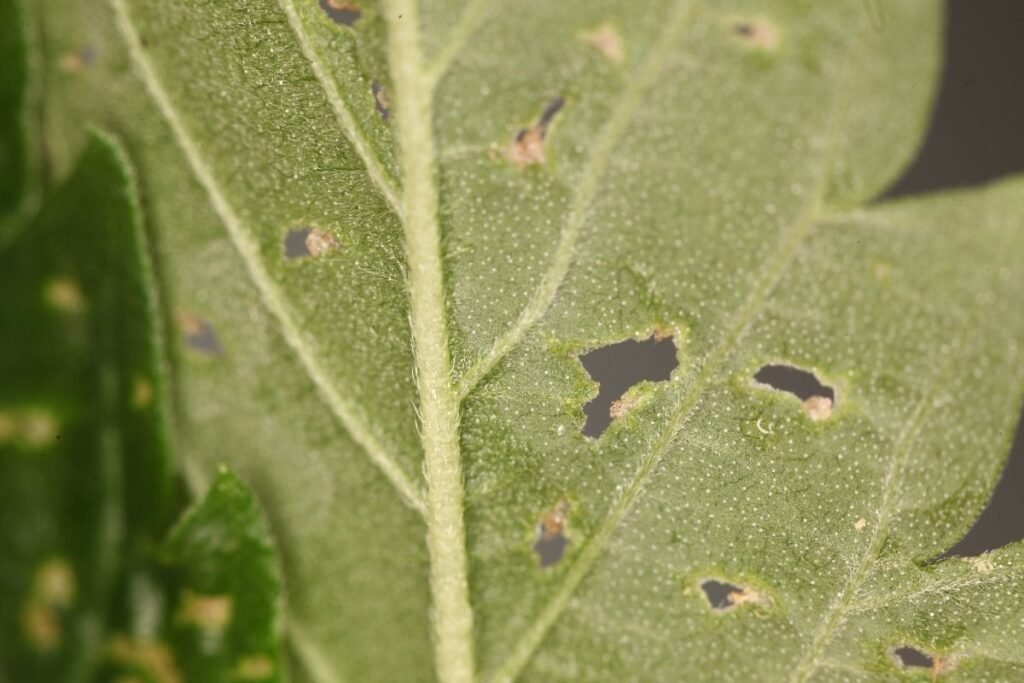
A trip outside can be a welcome change for many indoor plants. However, outside conditions can expose your house plants to many pests, fungal contamination, diseases, and even viruses. With that in mind, when finding the best place for your plants, it’s a good idea to consider their immediate surroundings. If you are placing them beside other outdoor plants, shrubs, or trees, just be sure to check them for anything that looks a little sinister.
If you spot anything that looks like it wouldn’t be too kind to your plants like aphids, spider mites, mildews, fungal growth, or any other inauspicious happenings, it’s probably best you find a different spot for your indoor plants. After all, when bringing your houseplants back inside, the last thing you want to do is to bring anything indoors that may infect your other healthy houseplants.
Harden off your house plants (particularly if you plan on leaving them outdoors over the summer months)
Plants certainly don’t appreciate a sudden change in conditions, whether that be light, temperature, water, or nutrients. And when you think about it, it kinda makes perfect sense. Many of these variables, whether it be light, water, or temperature, fluctuate slowly with the natural change of the seasons, they certainly don’t change abruptly like they do when a plant owner decides to suddenly change something like direct light.
Also, keep in mind, this change will often be felt even more dramatically by plants that have adapted to tropical conditions, in these environments seasonal change is basically limited to a wet and dry season that both remain relatively warm and humid all year round.
So, taking this into consideration, perhaps the best precaution you can take to get your indoor plants prepped and ready for outside conditions is to use a strategy horticulturalists have termed “hardening off”. All hardening off involves is slowly getting your houseplants used to the extremities of outdoor life.
To achieve this, you need to change the conditions your houseplants are exposed to over time slowly. Start by putting your plants outside in a shady spot during the daytime hours, and then bring them indoors before the cooler nighttime conditions set in. Over time, you can slowly increase the amount of sunlight they receive and even start to leave them outside overnight if you wish to. Just be aware, that no matter how much you harden some plants off, they are still limited to their evolutionary path, and even the most stringent hardening off period won’t get them used to direct sunlight or super cold temperatures.
Benefits of watering your house plants with rainwater
If administered correctly, indoor plants love a good dash of clean, natural rainwater.
Here’s why.
Nutrient-rich rainwater
While tap water is generally fine to use on houseplants, they actually much prefer rainwater. Why? Well, rainwater is chocked full of life-giving micro and macronutrients that both help with growth, meristem development (the “growing tips” of buds and root), and overall plant health.
In particular, rainwater is high in nitrates, an important macro-nutrient that is captured from the atmosphere by falling rain and delivered to the plant through the soil it resides in. What is nitrate? Well, it’s the most bio-available form of nitrogen, a chemical mix of both nitrogen and oxygen, and one of the key nutrients plants require for growth.
Just so you understand the process completely, plants actually don’t absorb nitrate straight from the water that enters the soil. What happens instead is beneficial soil-borne bacteria and archaea deliver nitrogen to a plant’s root hairs, through a process called “nitrogen fixation”, in exchange for sugars in the form of carbohydrates, a compound produced by photosynthesis. The microbes do this by converting atmospheric nitrogen from the air (N2) and turn it into ammonia (NH3), the perfect form for plants to indulge in.
In fact, research exploring the idea that rainwater is preferred for plant health over tap water found that rainwater is optimal for a range of different metrics. For one, plants (in this case lettuce) grown on rainwater demonstrated that some nutrient contents were higher, plant growth was better, and root and shoot activity was increased. Pretty neat, right?
Clean and toxic-free hydration
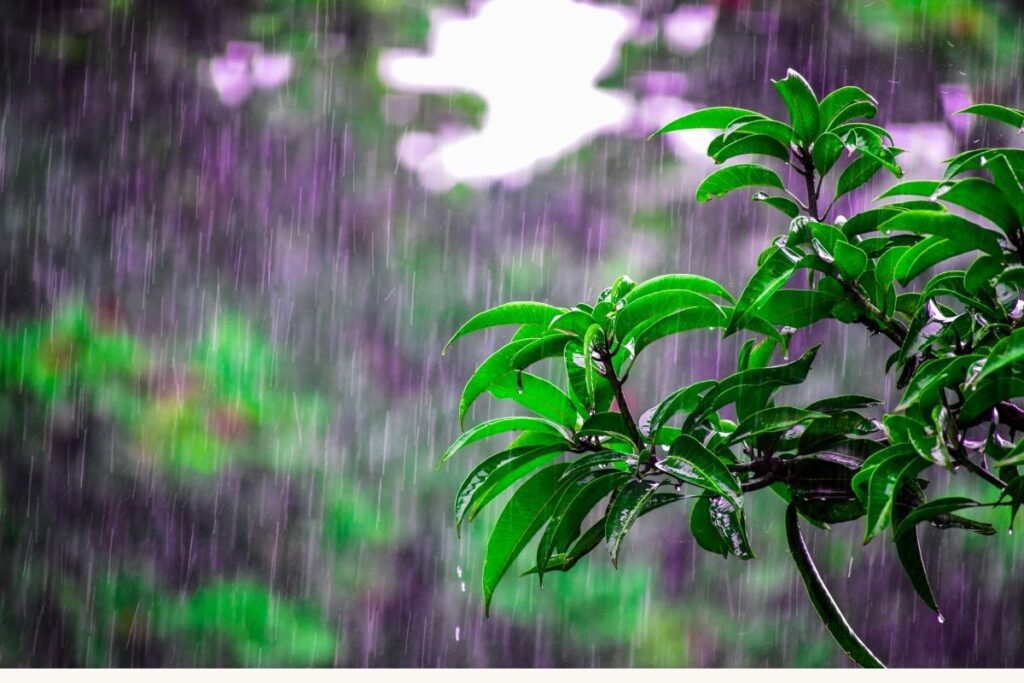
Another big reason why rainwater is so good compared to tap water is that tap water is often tainted with harmful chemicals like heavy metals, harmful contaminants such as microplastics, and even traces of herbicide like glyphosate. Not exactly something you want to feed plants if you wish them to be healthy and happy.
Other chemicals that are often found in tap water are chlorine and fluoride. Chlorine is used in drinking water as a disinfectant and fluoride as a means to prevent human tooth decay. And, while necessary to plant health in small doses, in excess chlorine and fluoride aren’t great for plant health.
In fact, these two chemicals are known to burn leaf margins, scorch leaves, and even build up in plant tissue, causing all sorts of health issues. Couple this with chlorine’s ability to affect soil health and kill off beneficial soil-borne microorganisms, and you can soon see why rainwater is a much-preferred way of hydrating indoor plants (and FYI perhaps yourself).
Clear mineral and salt build-up
Salts like magnesium or minerals like calcium are also often found in tap water. In fact, sodium is often added to tap water to soften these minerals that quite often harden and block water pipes. You’ll know exactly what these minerals look like if you have any of your plants in terracotta pots.
After a plant has been housed in a terracotta pot for a period of time, calcium and other minerals that percolate through the porous surface of the terracotta can often be seen collecting on the outside of the pot.
In excess, minerals like this can actually damage plant tissue. On a plant, just like a pot, you’ll sometimes notice this as white sediment sometimes seen on plant leaves. And rainwater is the perfect antidote to mineral and salt build-up. Another great reason to expose your indoor plants to a bit of clean rainwater every now and again.
Wash away built-up dust and debris
Whether it be dirt, debris, mineral salts, or just plain old gunk, plant leaves need to be cleaned every once and a while. Without a good cleaning, plants’ metabolic processes, like photosynthesis, can be affected. If this occurs, it has the potential to slow plant growth, increase the chances of disease and virus contraction, and really just doesn’t look great.
And while it is fun to grab a spray bottle and a microfiber cloth out to scrub your plants clean, it’s not always practical or time-efficient to do so. That’s where rain presents us the opportunity to do the hard work for use and clean up plant leaves, leaving them looking fresh, healthy, and happy.
Maximize photosynthesis
Water affects plants’ rates of photosynthesis, a vital metabolic process that all plants require for their survival. This is because photosynthesis manufactures plant food in the form of sugar, plus it regulates gas exchange, the way a plant inhales and exhales. Without it, a plant’s cells will become damaged, they will fail to grow, and they will eventually become deprived of vital nutrients.
So, a good drink from the heavens is just what the doctor ordered. In fact, just the right amount of water will maximize a plant’s rate of photosynthesis and subsequently allow it to grow at its greatest potential. Couple this with the added nutrients that rainwater carries, and you have yourself a beneficial chemical soup that indoor plants simply can’t get enough of.
Water indoor plants with snow
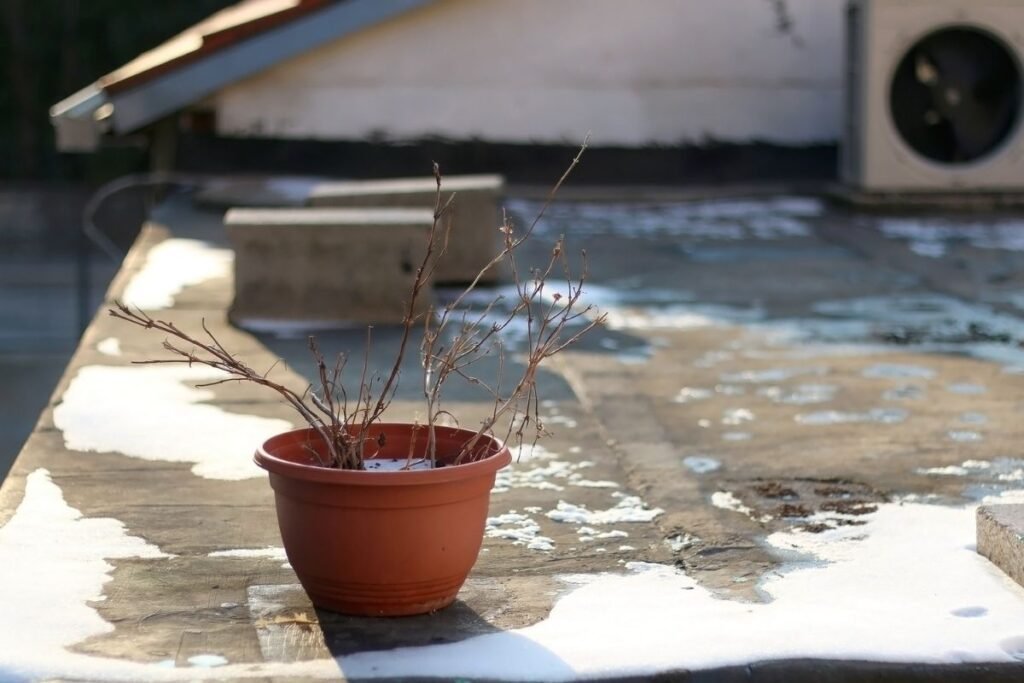
You want to give your houseplants the benefit of rainwater but it’s too cold outside, the snow is falling, and your house plants are all tucked in, warm, and ready to sit the winter months out.
So, what do you do?
Well, one thing you certainly don’t do is go and grab a whole handful of snow and dump it on the base of your plants. Or worse, against their trunks, stems, or petioles. This would only cause frostbite and damaged plant tissue.
Instead, you grab yourself a bucket, watering can, or spray bottle, fill it full of snow and allow it to melt and warm to room temperature. Once the snow is all melted and warmed, you can now use it on your plants, giving them all the benefits of rainwater without the chilly conditions or cryotherapy.
10 plants that can go outside in the rain
1. pothos varieties
Pothos species found their ecological footing in subtropical and tropical areas of China, the Indian Subcontinent, Australia, New Guinea, Southeast Asia, and various islands of the Pacific and Indian Oceans. This makes these widely cultivated plants quite adaptable to moist soil, some growers even keep different Pothos species and variations as aquaponically grown house plants. So, Pothos is quite suited to be placed outside when it’s raining.
Just be sure your plant is not placed in direct sunlight, partial or full shade is best. And if it begins to rain heavily, perhaps it’s best to come back indoors. Pothos plants, and most house plants, enjoy soil to remain moist but not soaked. So heavy rain is a no-go for long periods of time and full sun is a definite no, no.
2. ferns varieties
Many fern species, particularly those used to compliment an indoor space, are traditionally tropical plants that have evolved and adapted to dense rainforests and understory living, so they will jump at the chance of a decent drenching. Just be sure conditions aren’t too cold and be certain you check on them every once in a while. The last thing you want is for them exposed to direct sun or heavy winds.
3. swiss cheese plant varieties (monstera)
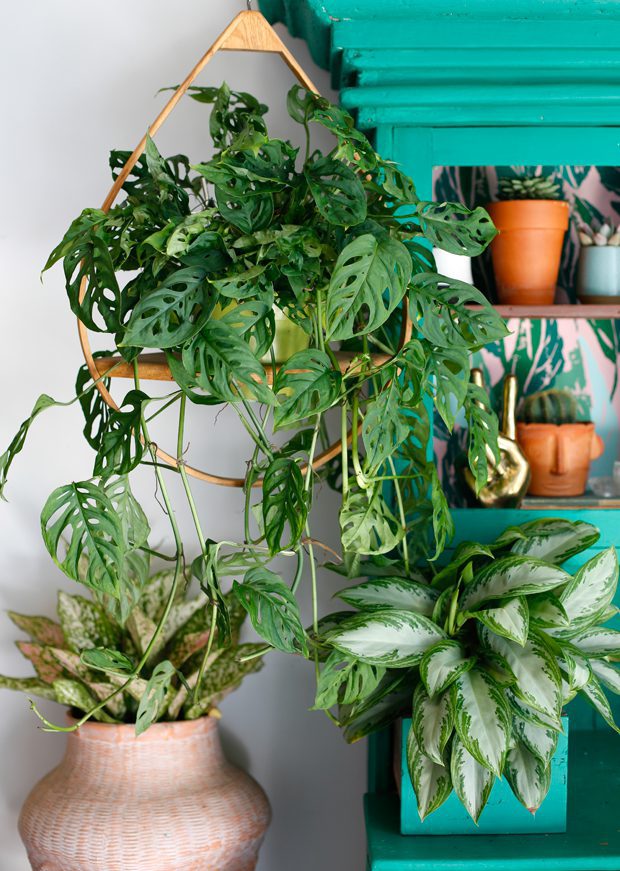
Your Monstera’s ancestors found their way to your home all the way from the Central American rainforests. This makes Swiss Cheese Plants great candidates for a good watering from the heavens. Just be sure to keep an eye on the clouds as your Monstera was once an under-canopy species and really doesn’t enjoy direct sunlight.
4. orchid varieties
Orchids are epiphytes, once finding their homes nestled against the trunks of tall rainforest trees or upon boulders or stones that form rocky outcrops that litter the forest floor. Being rainforest plants, most orchids enjoy plenty of water, particularly on their exposed roots and root hairs. But, like many house plant varieties, orchids don’t take kindly to harsh sunlight and are certainly not fans of cold temperatures.
5. spider plant varieties (chlorophytum)
Spider plants are native to the tropical and subtropical areas of Africa, Asia, and Australia. And are quite adaptive to growing outdoors. In fact, Spider plants quite like living outside in warmer regions, they make plants for hanging baskets and are quite happy to hang out outside if the weather permits. Just be sure to avoid exposing them to frost or direct sun, particularly when the sun’s at its harshest in the early afternoon.
6. snake plant varieties (sansevieria)
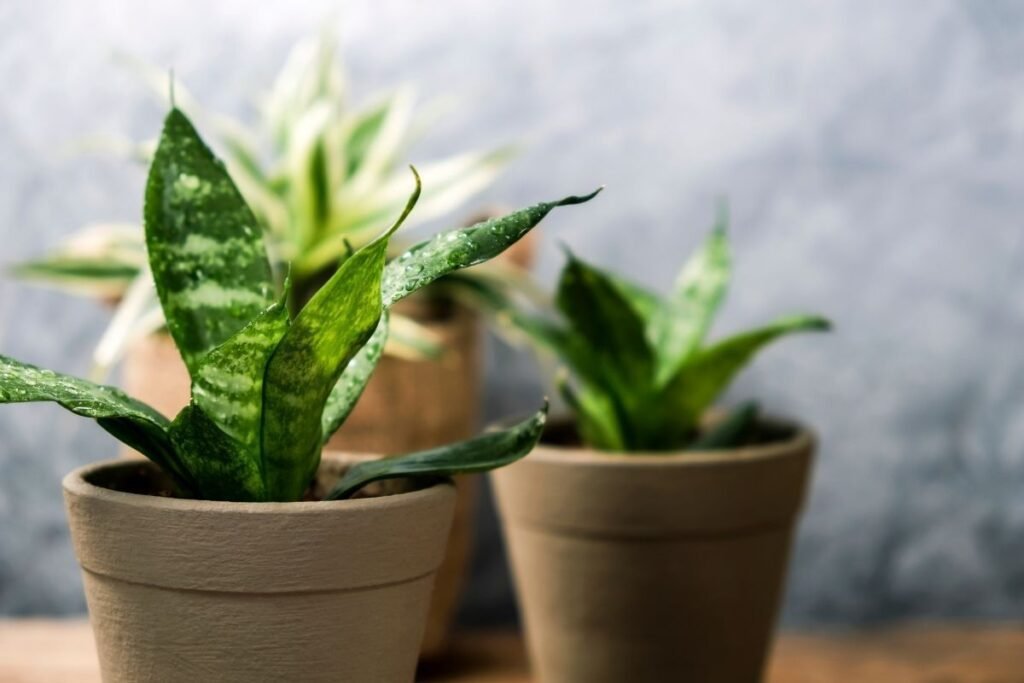
Snake Plants are native to the rocky and tropical regions of West Africa. They are very hardy plants that are super adaptable, enjoy varying light conditions, and do quite enjoy a nice drink of rainwater with their favorite fertilizer. Although, because of their origins, they do prefer to dry out between waterings. So if you’re going to frequently place them outside, make sure they get a break every now and again to regain their thirst.
7. fig varieties (ficus)
Ficus species, commonly known as figs, belong to a huge genus of over 900 known varieties, finding their origins in tropical, neotropical, and subtropical regions like Australia, East Asia, Papua New Guinea, the Pacific Islands, Central and South America, and Africa. This makes them quite used to large amounts of rain, high levels of humidity, and preferably warmth.
Just keep in mind, if you’re going to put your fig tree outside, understand they definitely do not enjoy direct sunlight. Their often large sensitive leaves, adapted to understory conditions, will burn easily and their usual variations of beautiful deep green, purples, and reds will become scarred with brown and grey scorch marks. Avoid cold temperatures as well and, whatever you do, don’t expose them to frosts.
8. philodendron varieties
Most Philodendron plants originate from the humid, tropical forests of the Americas and the West Indies. Although, some species are natively and endemically found growing in swamps and alongside river banks. So, you guessed it, they don’t mind getting a little wet.
And although more sun resilient than many other house plant species, a sudden change in conditions like exposure to more sunlight than they are accustomed to will likely damage their leaf tissue. So just be careful to bring them back inside or move them to a shady spot when the rain clouds clear up.
9. Syngonium varieties
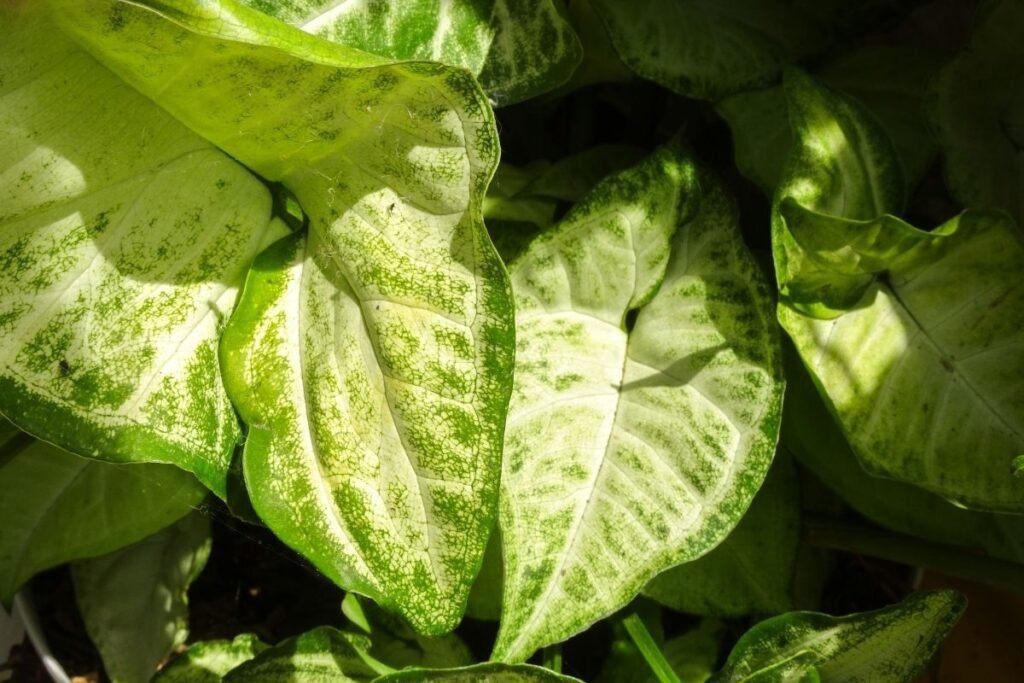
Syngonium species are native to the tropical rainforests, subtropical forests, thickets, and wetlands of tropical America ranging from Mexico to Brazil. This makes these attractive little plants very accustomed to wet conditions.
It is important to note that they, like many plants, do enjoy a period of drying out between watering. So if the rain is particularly heavy or it sticks around for a few days, just be sure that your Syngonium doesn’t get overwatered and become choked of the oxygen and nutrients that reside in its potting medium.
10. hoya varieties
And last, but certainly not least, if you own a beautiful Hoya plant you’re in luck, they quite enjoy rainwater too. Hoya species are predominantly native to the Phillippines and New Guinea. And this genus, like the orchids, largely exhibit epiphytism, meaning they form symbiotic relationships with larger plants that enable hoyas to climb, making their hosts bark or outer surface their homes.
Hoya plants enjoy bright but indirect light and enjoy being moist but not wet, so light rain is properly their most preferred outdoor condition.
Conclusion
Some plants absolutely adore being exposed to rain and outdoor conditions. Just be sure to keep in mind their indoor conditions and try to match them as closely as you can to a spot outside in your backyard. If you get this right, house plants are sure to thank you for being a good drink of rainwater.
After all, rainwater is choke-full of healthy things like macro and micro-nutrients, it clears their potting medium of any built-up salts and minerals, it helps regulate their gas exchange, plus they’ll thoroughly enjoy a good bath that washes them clean of any house debris and dust.
This is all sure to keep them super happy and healthy, which will no doubt bring a big old smile to your face.
Happy indoor gardening!
More about watering plants
- How Often To Water Dracaena (Including Snake Plants)
- How to Use Leca for Plants: Step-by-Step Guide with Pictures
- How To Save An Overwatered Snake Plant
- How Often To Water Pothos Plants (And When To Cut Back)
- How Often To Water Monstera Plants
- 11 Plants That Don’t Need Drainage And How To Care For Them
- Save Your Overwatered Monstera In 4 Steps (And How Not To Do It Again)


What can I plant outside that would thrive on rain water only. I do not want to physically water it. I am referring to is plants I want to put in my back yard.
Hi, Guelda! Lots of plants like to be outside 🙂 I would check your plant zone here: https://planthardiness.ars.usda.gov/ This will give you a good idea of what kind of climate you’re in and which kinds of plants will naturally thrive in that climate. The easiest thing to make plants happy is to match them with the environment they call “home”.
I enjoyed reading your write-up on plant care during monsoon rains. It is so formative and useful. Tonnes of thanks.
Glad to hear it! Be sure to cover your plants if the rain gets too heavy 😉